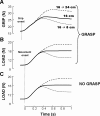Can the human brain predict the consequences of arm movement corrections when transporting an object? Hints from grip force adjustments
- PMID: 18032655
- PMCID: PMC6673284
- DOI: 10.1523/JNEUROSCI.3110-07.2007
Can the human brain predict the consequences of arm movement corrections when transporting an object? Hints from grip force adjustments
Abstract
It is well established that motor prediction is crucial for many of our daily actions. However, it is still unclear whether the brain generates motor prediction in real time. To challenge this idea, grip force was monitored while subjects had to transport a hand-held object to a visual target that could move unexpectedly. In agreement with previous reports, subjects triggered fast arm movement corrections to bring the object to the new target location. In addition, we found that subjects initiated grip force adjustments before or in synchrony with arm movement corrections. Throughout the movement, grip force anticipated the mechanical consequences resulting from arm motion, even when it was substantially corrected. Moreover, the predictive control of grip force did not interfere with the on-line control of arm trajectory. Altogether, our results suggest that motor prediction is an automatic, real-time process operating during movement execution and correction.
Figures




Comment in
-
Don'T let it slip: predictive control of grip force after changes in task goals.J Neurosci. 2008 Mar 19;28(12):2965-6. doi: 10.1523/JNEUROSCI.0110-08.2008. J Neurosci. 2008. PMID: 18353999 Free PMC article. No abstract available.
References
-
- Danion F. The contribution of non-digital afferent signals to grip force adjustments evoked by brisk unloading of the arm or the held object. Clin Neurophysiol. 2007;118:146–154. - PubMed
-
- Danion F, Descoins M, Bootsma R. Aging affects the predictive control of grip force during object manipulation. Exp Brain Res. 2007;180:123–137. - PubMed
-
- Day BL, Brown P. Evidence for subcortical involvement in the visual control of human reaching. Brain. 2001;124:1832–1840. - PubMed
-
- Day BL, Lyon IN. Voluntary modification of automatic arm movements evoked by motion of a visual target. Exp Brain Res. 2000;130:159–168. - PubMed
Publication types
MeSH terms
LinkOut - more resources
Full Text Sources
